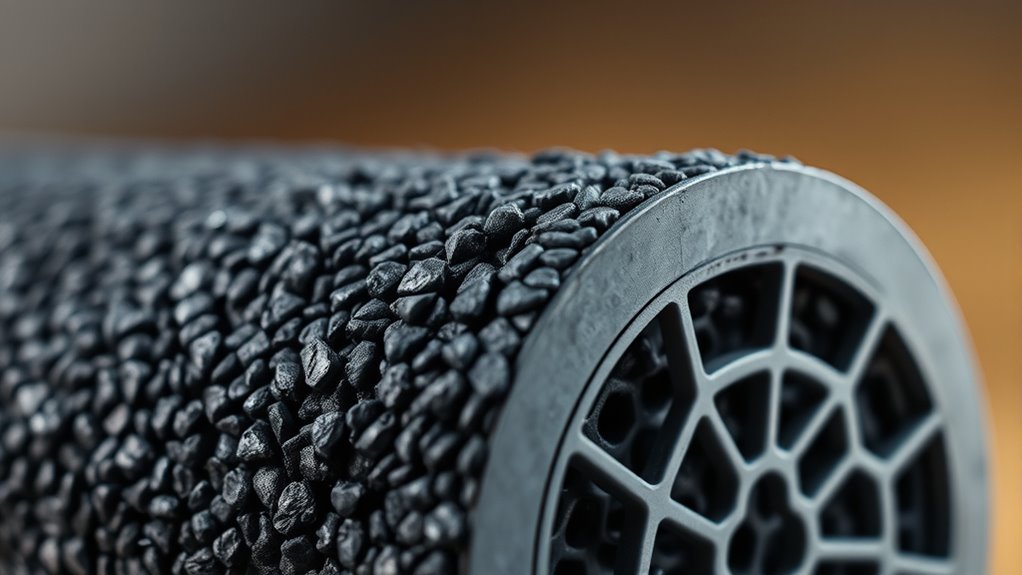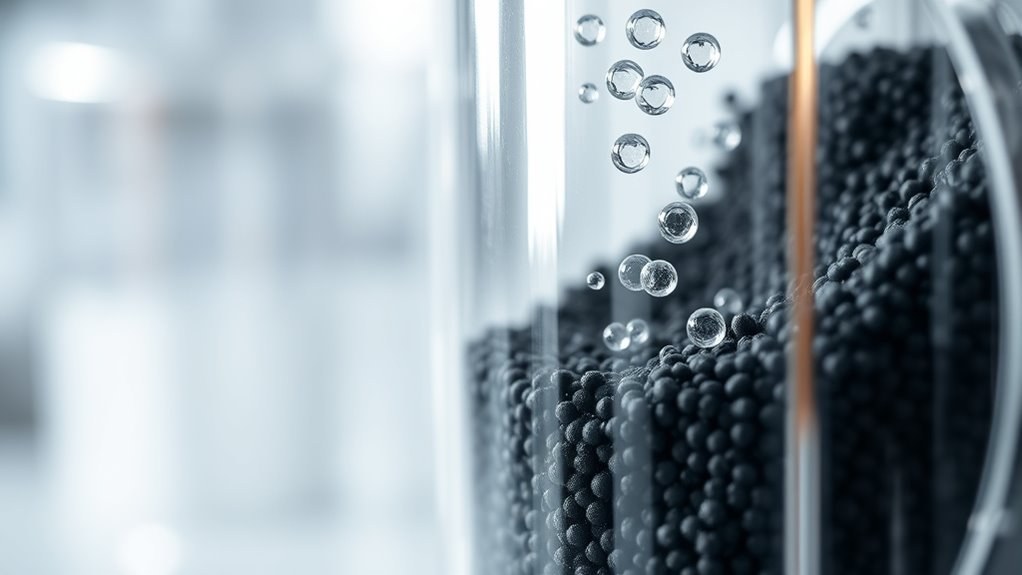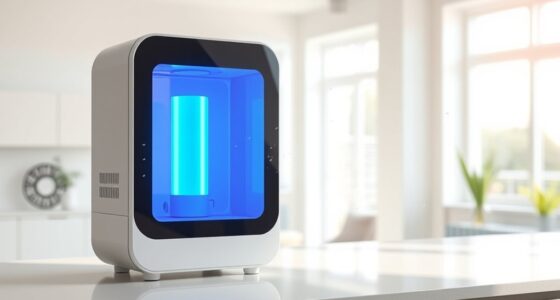Activated carbon filters remove impurities through a process called adsorption, where contaminants stick to the extensive pore network within the carbon material. These tiny pores trap chemicals, odors, and gases by leveraging forces like van der Waals attractions, effectively purifying air and water. The large surface area of activated carbon enhances its capacity to adsorb multiple molecules at once. If you want to understand how the pore structure and surface properties make this possible, there’s more to discover below.
Key Takeaways
- Activated carbon’s extensive pore network provides a large surface area for trapping contaminants.
- Adsorption occurs as molecules adhere to the carbon surface through intermolecular forces like van der Waals.
- Micropores selectively capture small molecules such as VOCs and pesticides, enhancing removal efficiency.
- The process depends on pore size, surface area, and the interaction between contaminants and the carbon surface.
- Regular replacement or regeneration of the filter maintains optimal adsorption capacity and filter performance.

Have you ever wondered how activated carbon filters effectively remove impurities from water and air? The secret lies in their unique carbon pore structure and the way they utilize adsorption mechanisms. When you pass water or air through an activated carbon filter, you’re fundamentally allowing substances to stick to its surface, removing contaminants efficiently. This process hinges on the intricate design of the carbon’s pore structure, which plays a vital role in trapping various impurities.
Activated carbon’s carbon pore structure is highly porous, featuring millions of tiny holes called pores. These pores come in different sizes—micropores, mesopores, and macropores—each targeting different types of molecules. Micropores, which are less than 2 nanometers wide, are particularly effective at adsorbing small molecules like volatile organic compounds (VOCs) and certain pesticides. The extensive pore network provides a vast surface area, often exceeding 1,000 square meters per gram of carbon, giving it an incredible capacity to adsorb contaminants. When impurities come into contact with these pores, they are drawn into the tiny spaces, where they become trapped and held.
Activated carbon’s tiny pores maximize surface area to trap and hold impurities effectively.
The core of an activated carbon filter’s effectiveness lies in its adsorption mechanisms. Unlike filtration that physically blocks particles based on size, adsorption involves molecules adhering to the surface of the carbon. This process is driven by several intermolecular forces, including van der Waals forces and electrostatic attractions. When a contaminant molecule encounters the surface of activated carbon, it experiences a pull due to these forces, causing it to stick. The greater the surface area exposed by the pore structure, the more molecules can be adsorbed simultaneously. This means that activated carbon can target a broad spectrum of impurities, from chemicals and odors to dissolved gases.
As water or air passes through the filter, the adsorption process continues until the carbon’s surface is saturated—meaning no more molecules can be attracted. That’s why filters need regular replacement or regeneration. The efficiency of adsorption is also influenced by factors like temperature, pH, and the presence of competing substances. For example, a high concentration of one impurity might prevent the carbon from adsorbing others effectively, which is why pre-treatment or multiple filtration stages are sometimes necessary.
Additionally, the pore size distribution of activated carbon can be tailored during manufacturing to optimize its effectiveness for specific contaminants. In short, activated carbon filters work so effectively because of their complex carbon pore structure that maximizes surface area and the adsorption mechanisms that draw contaminants into those tiny pores. This combination allows them to clean water and air by trapping a wide array of impurities, providing you with safer, clearer, and fresher results every time.
Frequently Asked Questions
How Long Does Activated Carbon Filter Effectiveness Typically Last?
Your activated carbon filter usually lasts about 3 to 6 months before needing replacement, depending on usage and water quality. Keep an eye on the filter lifespan, as it can vary based on the amount of contaminants it absorbs. Regular replacement guarantees peak performance. To maintain clean water, follow the recommended replacement frequency, typically every few months, or sooner if you notice a decline in water taste or flow rate.
Can Activated Carbon Remove Viruses From Water or Air?
Activated carbon filters can help with virus removal in air purification, but they are not fully effective against all viruses in water or air. For air, they reduce some airborne viruses and odors, but for water, specialized filters like UV or reverse osmosis are more reliable. You should combine activated carbon with other purification methods to guarantee thorough virus removal, especially in critical environments.
Is Activated Carbon Safe for Use in Food and Beverages?
You’ll be glad to know activated carbon is safe for use in food and beverages. It’s widely trusted in food safety practices to improve beverage purity by removing impurities and contaminants. Manufacturers carefully process and test activated carbon to meet safety standards. So, when used correctly, it helps enhance your drinks without introducing harmful substances, ensuring your food and beverages remain safe and clean for consumption.
How Does Humidity Affect Activated Carbon’s Adsorption Capacity?
Humidity interference can diminish activated carbon’s adsorption capacity because moisture impacts its ability to trap contaminants. When humidity levels are high, moisture competes with pollutants for adsorption sites, decreasing efficiency. You might notice that in humid environments, filters don’t work as well, and odors or impurities persist longer. To maximize performance, it’s best to use activated carbon in dry conditions or ensure proper storage to minimize moisture impact.
Are There Environmental Concerns With Disposing of Used Activated Carbon?
You should be aware that disposing of used activated carbon can raise environmental concerns. If you don’t handle it properly, it could impact landfills and the environment. To minimize this, opt for eco-friendly disposal methods, such as recycling or using designated waste programs. Proper disposal reduces landfill impact and helps protect ecosystems from potential contaminants adsorbed onto the carbon, making sure you’re contributing to a more sustainable approach.
Conclusion
Now that you understand how activated carbon filters work through adsorption, you can see why they’re so effective at purifying air and water. With their porous structure trapping pollutants, you’re better equipped to choose the right filter for your needs. Isn’t it satisfying to know that a simple, natural process can make such a big difference in your environment? Next time you breathe clean air or drink fresh water, you’ll appreciate the science behind it even more.









